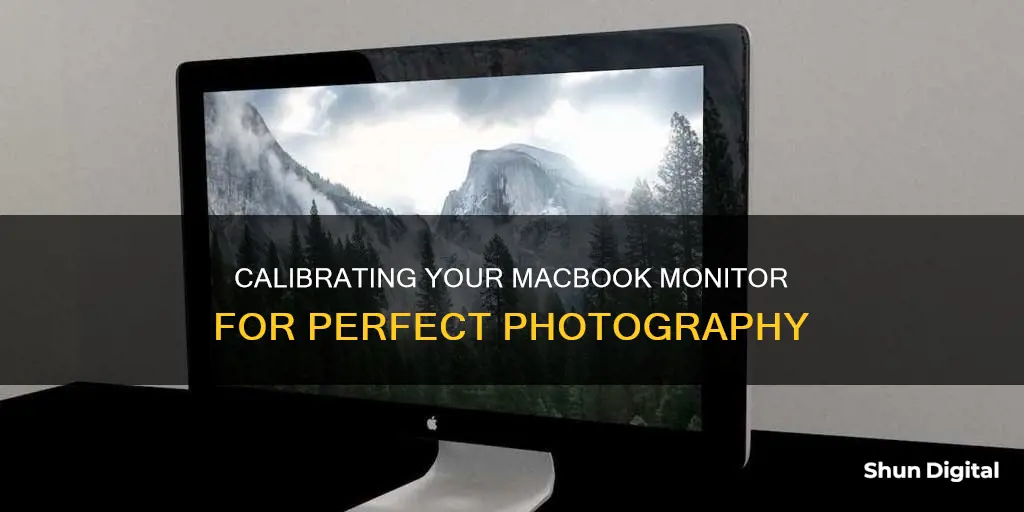
Calibrating your MacBook monitor is essential for photographers to ensure that the colours, brightness, and contrast are true to life. Monitor calibration compares your screen to an accepted standard to ensure consistency in how images are seen. Without calibration, your photos may appear differently on other devices or when printed. While MacBook monitors come pre-calibrated, this can change over time due to factors like ambient light and display age. Calibration ensures your edits are accurate and gives you peace of mind that your prints will look as intended. There are various options for calibrating your MacBook monitor, from free built-in and online tools to premium hardware solutions.
| Characteristics | Values |
|---|---|
| Purpose of calibration | To ensure that your eye sees the photo the same way on your screen as others will see it. |
| When to calibrate | When you first purchase your monitor and regularly thereafter. |
| Why calibrate | To make sure that your monitor is not too bright or too dark and that the colours are true to life. |
| Calibration methods | Built-in calibration methods, online calibration tools, calibration kits. |
| Calibration kit options | X-Rite i1Display Pro, Datacolor SpyderX. |
| Calibration kit prices | $170-$285 |
What You'll Learn

Calibration ensures colours are true to life
Calibration is the process of making your screen render colours with greater accuracy. It ensures that the colours, brightness, contrast, and vibrancy are true to life.
Monitor colour calibration compares your monitor to an accepted standard so that there can be consistency in how images are seen. If all monitors were calibrated, a photo would look the same regardless of the screen it is shown on.
Without calibration, your colour temperature can be very off and can throw off prints or shared photos. Calibration ensures that the edits you apply to a photo are accurate. It also helps to ensure that the picture looks good on social media and other calibrated monitors.
Monitor calibration can make a massive difference in the quality of work produced, yet it often gets overlooked. Calibrating your monitor is a good idea no matter what your profession. However, it is especially important for photographers.
Connecting PS2 to a VGA Monitor: A Step-by-Step Guide
You may want to see also

Calibration is important for consistency
Without calibration, your photos may appear differently on other devices. This is because each screen displays images differently. The same image will look different on a monitor, a phone screen, or a client's screen, as the inner workings of the screen itself vary. The user may also have adjusted their settings, which can result in different skin tones and product colours from monitor to monitor.
Calibration adds consistency to this situation. It employs a common standard so that any monitor using the standard will present the image in the same way. Professional printers are also calibrated to this standard so that what you see is what you get when it comes to printing.
Monitor calibration is also important for photographers who want to ensure their prints come out as expected. Without calibration, your colour temperature can be very off, and this can throw off prints or shared photos.
Even if you're not a professional photographer, calibration is important if you care about how your photographs are viewed by others. For example, if you edit your photos on a screen with high contrast, it may not show you all the details in your RAW files. If you can't see all the data, you may end up editing the image in a way that permanently removes detail without you even knowing it.
Additionally, modern computer, tablet, and phone screens are designed to make photos look good, rather than for accuracy. Colours tend to be oversaturated, and the contrast is ramped up for maximum impact. This can make it difficult to edit your photos accurately.
By calibrating your screen, you can avoid these issues and ensure that your photos look consistent across different devices and that your prints turn out as expected.
Dismantling VE278 Monitors: Removing the Base Safely
You may want to see also

Calibration is needed for accurate photo editing
Calibration is essential for photographers to ensure that their images are displayed accurately and consistently across different devices and platforms. Without calibration, photographers run the risk of colours appearing differently on their screens compared to the final printed product or digital file. This discrepancy can be frustrating, especially after spending hours editing photos.
Calibration involves fine-tuning a monitor's settings, including colour, brightness, contrast, and vibrancy, to achieve true-to-life visuals. It ensures that the edits applied to a photo are accurate and consistent, regardless of the screen or device used for viewing. This consistency is crucial for professionals who rely on printed works, such as books, portfolios, and photographs.
Additionally, calibration helps convey the intended mood and message of the photographer's work. Colour accuracy is not just about aesthetics; it is essential for maintaining the integrity of the artwork. When colours shift unexpectedly, all the meticulous edits can be lost in translation.
The process of calibrating a monitor can be done using hardware and software solutions. Hardware calibrators, such as colourimeters and spectrophotometers, offer precise control over printer profiles and display calibration. Software solutions, on the other hand, include built-in operating system utilities and third-party tools like DisplayCAL.
While calibration is essential for accurate photo editing, it is also important to recognise that every screen is different, and images will always look slightly different on various devices. Photographers should test their images on multiple devices to ensure they look their best everywhere.
Monitor Impact on GPU Performance: Does Refresh Rate Matter?
You may want to see also

Calibration hardware is essential
Photographers need to be able to trust that what they see on their screen is an accurate reflection of how their work will look in its final form. The correct colour fidelity, gradations, colour temperature, brightness, and tone stability are characteristics that determine the accuracy of your screen.
A hardware-calibrated monitor will be colour-accurate regardless of which source or computer you connect it to. This is because a hardware LUT is stored on a dedicated chip inside the display, so the monitor receives the unadjusted RGB signal from the computer and then applies the colour corrections. This ensures that the monitor maintains its original colour gamut and that there is no truncation of the colour depth.
The results of hardware calibration are also longer-lasting than software-based solutions. Hardware calibration offers colour-critical professionals a reliable workflow that saves them time and money, with fewer recalibrations and on-screen colours that can be trusted.
While software calibration is widely accessible, it is labour-intensive and impractical for colour-critical work. It requires a great deal of manual adjustment, and the results may vary depending on the graphics board and other factors. The calibration will also be undone if the computer is rebooted.
Therefore, if you are a photographer looking to ensure accurate and consistent colour output, a hardware-calibrated monitor is essential.
Golden Tee 2005: Monitor Size for Optimal Gameplay
You may want to see also

Calibration should be regular
Calibration should be a regular part of your routine if you're a photographer using a MacBook monitor. Even if your monitor is brand new, it's important to calibrate it to ensure that the colours, brightness, contrast, and vibrancy are true to life. Monitor calibration compares your monitor to an accepted standard so that there can be consistency in how images are seen.
Over time, lights weaken, which can alter how the colours look. For this reason, it's a good idea to calibrate your monitor regularly to make sure its output is consistent. How often you calibrate depends on your personal preference and how often you use your monitor for editing photos. Some sources suggest calibrating once a month, while others suggest once every six months is sufficient.
If you're calibrating your MacBook monitor for the first time, it's worth noting that it will take longer than subsequent calibrations. This is because you'll need to spend time reading the instructions and downloading the software. After the initial calibration, the process will be quicker, and you can recalibrate your monitor in less than 20 minutes.
Regular calibration will ensure that the edits you apply to a photo are accurate and that the picture looks good on social media and other calibrated monitors. It will also give you peace of mind that any prints will come out looking exactly as you want them to.
Ankle Monitors: Who Wears Them and Why?
You may want to see also
Frequently asked questions
Calibration ensures that the colours, brightness, contrast, and vibrancy of your monitor are true to life. This is important for photographers because it ensures that the edits you apply to a photo are accurate and that the picture looks good on social media and other calibrated monitors.
It is recommended to calibrate your monitor regularly as the output changes over time. Lights weaken, which can alter how the colours look.
You can use built-in calibration methods, online calibration tools, or purchase a calibration kit.







